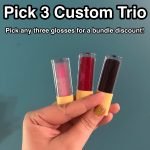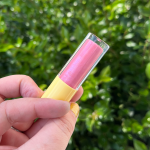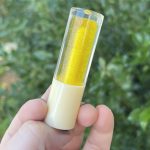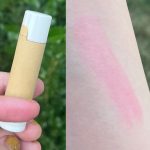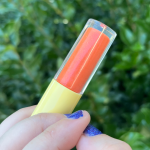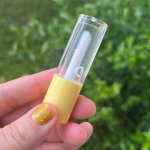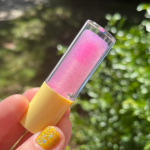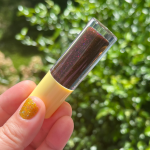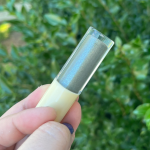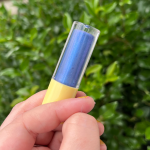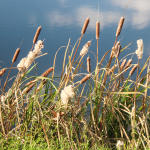Madison’s Flowers
Lip gloss inspired by the native plants of North Carolina
Shop on Etsy!
Bundles and sample sizes available, too!
Cercis canadensis (eastern redbud)
Gloss: pigmented pinky-mauve semi-sheer gloss with blue iridescent undertones; scented lightly of apple.

Namesake: C. canadensis is found up and down the eastern half of North America, and here in NC it’s one of our earliest spring bloomers! Since there are no leaves on the tree in earliest spring, the small, pink flowers grow in clusters all along the branches. As long as the trees aren’t being sprayed with chemicals you wouldn’t want to eat, you can actually grab a handful of the flowers as a snack or too make blossom syrups. Later in the year, it’s easy to spot that this tree is a member of the legume family, like peas and peanuts; the fruit of the tree hangs from the branches like miniature pea pods (which are also edible).
Notes from Madison: The reason this gloss is scented with apple is because that’s what the flowers of C. canadensis taste like to me! Redbuds are one of the trees I get asked, “What is that?!” the most because they’re common street trees and are one of the earliest bloomers–even before most cherry trees. The other commonly planted variety in this area in Cercis chinensis, which isn’t native but is much the same as its North American counterpart. Typically C. canadensis will have paler pink leaves in comparison to the more hot pink flowers of C. chinensis. Still, a redbud’s a redbud and I love them.
Dionaea muscipula (Venus flytrap)
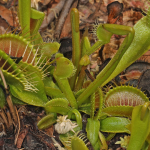
Gloss: Bright, maraschino-cherry red jelly gloss with with pink holographic glitter that leaves a long-wearing, aggressively 80s pink stain with a marshmallow scent.
Namesake: D. muscipula is native to the coastal lowlands of Eastern North and South Carolina and is one of the few species of carnivorous plants in the world. This gloss is named for the bright, alluring red of the inner surface of the lobed leaves that is “bait” of the famous trap before it snaps shut on its prey. Venus flytraps loom large in popular culture, and Wilmington, North Carolina is not only one of the few places in the world where native Venus flytraps grow wild, but is even more unique in that the three major types of carnivorous plants–Venus flytraps, sundews, and pitcher plants–grow wild together, side-by-side.
Notes from Madison: I went to Alderman Elementary School in Wilmington, and behind its playgrounds is one of the only muddy, humic paths in the entire world that lead to this sight. Lots of native carnivorous plant populations were decimated by poaching until better methods for commercial propagation and breeding were developed to satisfy the demand for these bog-dwelling plants.
Hamamelis virginiana (witch-hazel)
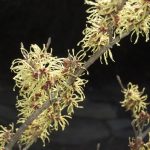
Gloss: Sheer yellow-tinted gloss with yellow iridescent flakies; formula is closer to a lip oil and very light weight. Scented like lemon poundcake
Namesake: H. virginiana is named for this shrubby tree’s early spring blossoms. The flowers bloom in winter after the leaves have fallen and feature bright yellow, shaggy ligulate (ribbon or strap-like) petals. It’s a woodland plant, so witch-hazels can tolerate shadier areas of a landscape and its fruits are popular with birds when food is scarce at the end of winter. There’s also a type of moth—Acronicta hamamelis, or dagger witch-hazel moth—whose larvae feed exclusively on witch-hazel and the adults pollinate the flowers. Witch-hazel has tons of medicinal uses, being sold as a common drugstore astringent and providing an active ingredient for hemorrhoid patches. There’s a lot of speculation about the etymology of witch-hazel, and Wikipedia reports it probably had its roots in an old English form of a word for pliable. It wasn’t historically associated with witches, but witch hazel was a favorite source of dowsing rods for white colonial expansionists. Oh, and the seed pods explode.
Notes from Madison: I love witch-hazels! They’re one of my favorite plants and I look forward to seeing the blooms every year! As someone who has worn my hair with bangs for decades, it’s easy for me to feel a little kinship to the shaggy flowers. I actually once wrote a Twilight fanfic where my OC was a dryad who took the form of a witch-hazel in tree form and eventually had to pretend to go to high school with the Cullens.
Lachnanthes caroliana (Carolina redroot)
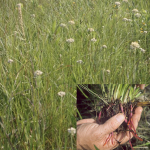
Lip balm: this moisturizing lip balm is pomegranate-mint scented and is also a blushing lip or cheek stain!
Namesake: L. caroliana is a coastal plains plant, growing in bogs and meadows up and down the east coast. The creamy, yellow flowers are like magnets for butterflies and birds, and are especially attractive to sandhill cranes! This grassy plant mainly spreads by root runners (rhizomes) from their striking cranberry colored roots.
Notes from Madison: I named this lip balm after L. caroliana because I like the way this unassuming balm develops into a flush of pink on the lips or cheeks–sort of like pulling up a plant and getting a pretty surprise!
Lilium superbum (lily royal)
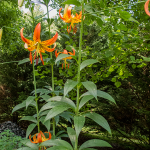
Gloss: Semi-sheer orange gloss goes on coral with rose gold shimmers; lightly scented of orange water and gardenia
Namesake: L. superbum is named for this East coast native lily blooms in the hottest, most humid parts of mid- to late-summer. The orange blossoms stand tall and both the petals and sepals (the little green leaves at the base of the flower head) curl outward and upward, looking like a grown or hat a swamp fairy might wear! You can plant these just about anywhere if you have good sun, sandy or even swamp-loamy soils, and good drainage (long periods of standing water can rot the bulbs).
Notes from Madison: This gloss was actually inspired and designed by my bandmate, Leigh! She’s a Baltimore girl with a penchant for warm coral and peach color palettes and serves big “pastel goth” energy. These lilies are some of the showiest and most recognizable plants native to the area, though they get less political glory than the state flower, black-eyed susans!
Monotropa uniflora (ghost pipe)
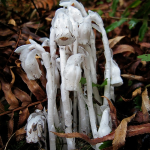
Gloss: clear gloss provides high shine but still moisturizes and softens lips. Faintly sweetened and scented with vanilla and can be paired as a topper for other glosses and lipsticks.
Namesake: M. uniflora is native to most of North America, and most typically grows in North Carolina in the mountains and piedmont. This plant lacks chlorophyll, meaning its remaining structures give it a semi-translucent white color instead of green. To get nutrients, M. uniflora is a saprophyte–it feeds from mycorrhizal fungus that grow in the roots of other plants nearby. Unlike parasites, saprophytes don’t harm their hosts. Since M. uniflora doesn’t rely directly on sun, it can grow in very dark, spooky places!
Notes from Madison: I’m hoping to track down one of these in the wild next time I’m off the beaten path again. They grow wild here in Wake county, but they’re fairly small plants (about five inches high, give or take) and easy to miss or confuse with mushrooms at a distance! If you live in North America in a temperate, forested area, keep an eye out for these in bloom all summer.
Rhododendron periclymenoides (pinxsterbloom azalea)
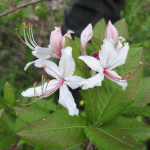
Gloss: Sheer lip gloss with pink holographic glitter and subtle wash of pink lip stain that develops over a few minutes with a light, floral scent.
Namesake: R. periclymenoides is a North American species of azaleas native to the mountains of North Carloina and features pale pink flowers with long, wispy stamens and thrives in the moist understories of forests. Like other rhododendrons, azaleas are cousins of the blueberry. This gloss in named for the delicate, cool-toned shades of pink frequently sported when this azalea flowers.
Notes from Madison: I grew up in Wilmington, North Carolina, home of the Azalea Festival, and we had a mix of Asian and North American species of azalea in our yard totally by chance.
Rubus argutus (sawtooth blackberry)
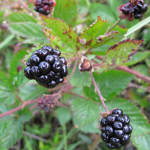
Namesake: R. argutus is the most common bramble blackberry throughout North Carolina. This gloss is named for the edible fruits of the plant; these distinctive compound drupe fruits are colloquially called berries and are related to other brambles berries like raspberries, and are cousins of other drupe fruits (commonly called stone fruits) like peaches and plums.
Gloss: Dark plum lip gloss with complementary holographic glitter, leaves a long-wearing fuchsia stain on the lips with a blackberry vanilla scent.
Notes from Madison: R. argutus is the primary blackberry bramble that grows along the treeline on the North Carolina Museum of Art grounds in Raleigh, and its berries are popular snacks for both birds and humans enjoying its trails. If you’re interested in the twenty-year project to study and control invasive plant species on the NCMA grounds, R. argutus features prominently in sections of “Effect of invasive species removal on the understory of an urban forest” by Patrick Chess (2011).
Tillandsia usenoides (spanish moss)
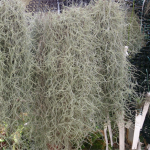
Gloss: Semi-sheer gloss is silver with green undertones with silver holographic glitter and iridescent green flakes; lightly scented of pistachio
Namesake: T. usenoides is named for the curly, grey-green plants that hang thick over trees–especially live oaks–up and down the most maritime parts of the Southern coast. It’s actually a very close relative of what are commonly sold as “air plants,” frequently sitting in shells, tiny pots glued to fridge magnets, or other decorative presentations. Despite the common name of “moss,” tillandsias are a flowering plant (check for teeny-tiny rust-red flowers in the tangle of gray leaves) andare in the same family as bromeliads. Spanish moss isn’t parasitic to its host; it’s a type of plant called an epiphyte, meaning it just sits on top of its host to get a better seat for the sun, so to speak. Unless the Spanish moss is weighing down a weak branch, they usually won’t choke out or harm their host tree and you can just enjoy the silvery tangles. When dried, they’re also commonly used in arts and crafts, too.
Notes from Madison: I grew up in Wilmington, NC and have a fondness for the delicate silver of these somewhat misunderstood plants. When I volunteered in the New Hanover County Extension Plant Clinic, tillandsia was mistaken for a form of lichen (a symbiotic cluster of fungus and algae that’s a similar color but grows on the ground). We used to take this down out of trees and make wigs as kids!
Typha latifolia (broadleaf cattail)
Gloss: suede color gloss is semi-opaque with iridescent green/gold duochrome pigment; lightly pecan scented.
Namesake: T. latifolia is named for the broadleaf cattail, a common sight around lakes, creeks, roadside ditches, and marshy areas all over the state. Most of the plant is actually edible; native cattails have starchy roots, delicate shoots, and even the flower heads are edible if they’re still immature! Once it blooms into that classic brown “cattail” that will start puffing its seeds off, leave it for the birds! (As always, use caution when foraging and avoid plants affected by contaminates or contaminated runoff!)
Notes from Madison: Some of my favorite memories of this plant are from middle school, when my family would go camping with my brother’s Boy Scout troop. I think I remember this being at Blueberry Hill campground outside of Burgaw, but I’ll have to double check my memory! Blowing on a blooming cattail felt like having the biggest, best dandelion!
Vaccinium virgatum (rabbiteye blueberry)
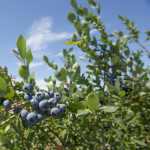
Gloss: shimmery blue semi-sheer gloss with purple iridescent glitter, lightly blueberry scented
Namesake: V. virgatum is one of the native blueberry species to North Carolina and grows best in more acidic soils (about pH 4.5-5.5, but your individual plant and conditions can vary!). If you’re trying to grow these shrubs at home, the NC Cooperative Extension Service pairs with the NC Department of Agriculture to provide free soil testing to residents. If you live in North Carolina, find more information or your local extension office here! While the gloss is blue, what reminds me the most of blueberries in the frostiness; it reminds me of the whitish, waxy (also called glaucous) coating on the berries.
Notes from Madison: My first time recognizing different kinds of blueberries was in college, where I had the opportinuty to work with the NC State sweetpotato breeding program. This included field work in the summer sun, but one of the best parts of visiting one of the sites was that they were also doing blueberry trials there. They were looking at disease resistance in the plants, so we could pick and eat all the berries we wanted on the spot since they were pesticide-free. The two I remember most are the rabbiteyes and southern highbush blueberries; they tend to have a more oval shape and are larger than most commercial blueberry varieties.
Weedy Gloss – minis, freebies, and extras
A “weed” is just a plant growing where you don’t want it or where you don’t expect it–that’s sort of like Weedy Gloss!
Your package may include teeny tiny tester tubes of glosses I’m testing or even the “extra” gloss from filling tubes mixed together into a new shade. They aren’t all winners–I’m still trying to make a black gloss I’m happy with–but I put complementary shades and scents together when I’m mixing or you might get two different formulas of the same color to compare! Weedy Gloss may contain any of the ingredients listed on this page.
About stains and how to clean them
Lip staining glosses have an underlying pink stain; intensity varies by gloss and skin tone. Color develops after contact with skin. Like any makeup, pigments may stain clothing. After testing this on fabric, I found that the blue Dawn dish soap and micellar water removed the pink pigment from cotton.
Ingredients
Base: Mineral Oil, Hydrogenated Polyisobutene, Polybutene, Polyisobutene, Caprylic/capric triglyceride (fractionated coconut oil), Ethylene/Propylene/Styrene Copolymer, Tocopheryl Acetate (Vitamin E), Simmondsia Chinensis (Jojoba) Seed Oil, Butylene/Ethylene/Styrene Copolymer, Pentaerythrityl Tetra-di-t-butyl Hydroxyhydrocinnamate, Caprylyl Glycol, Phenoxyethanol, Hexylene
Flavoring: Soybean Oil, Benzyl Alcohol, Artificial Flavors, stevia extract
Glitter: Polyethylene Terephalate, Aluminum, Polyurethane 33, Pigment
Pigment: Ricinus communis (castor) Seed Oil, Red 27
Additional Pigments for Rubus argutus
Red 21, black iron oxide (lightly magnetic)
Additional Pigments for Rhododendron periclymenoides
N/A
Additional Pigments for Dionaea muscipula
Red 21
Safety Information
Glosses are made in my kitchen on sanitized surfaces with gloves and my hair covered. Pigments Red 21 and Red 27 are not USFDA approved for use around the eyes, but are safe for other areas of skin. Pigments Red 21 and Red 27 are considered eye-safe in the EU. Black iron oxide is lightly magnetic. Products contain coconut oils.
